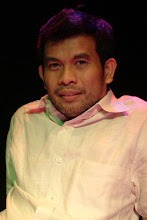Natural Man Naturally
Zulkifli Mohamad
Djaelantik, the Prince of Bali defined that aesthetics is related to two things: language and arts object. Language is used to describe, explain, and discuss aesthetics. On the other hand, without art object, the discussion about aesthetics is useless. For us is to enjoy the arts and to discuss the aesthetics.
What I am about to tell you here is just a little story about the Natural Man. Though Sir Alfred Russell Wallace, the natural scientist who did years of research on proboscis monkeys in Sarawak Borneo in the late 1800 had came up with the book called “Natural Man” in the early 1900, I only read the book after I discovered my own Natural Man in 1993. It only took me one visit to the Iban longhouse in Sarawak jungle, before I was adopted by the Iban headman of the village to see how he spends his days and nights - being the headman of the village, father to four children, farmer in the morning when he leaves the house at 5 o’clock, woodcarver at 10 o’clock when he is back from the farm while sipping his coffee, fisherman/ hunter after lunch as he leaves again to get some fish at the river or some animal in the nearby jungle, musician-dancer after dinner and drink as he starts playing gong and canang and dance his ngajat, as headman as he delivers his speech to children of the village including his own. Wallace’s Natural Man is about how the man lived with his environment – trees, rivers, hills and mountains, clouds, earth and animals. Ronald Tamplin (1997) might say that Arts is everywhere; all around, but is the Natural Man sees the same way as Tamplin. Perhaps it is just a pure and simple artful living all round for the natural man.
Wyszomirski (2003) in “Creative Industries and Cultural Professions in the 21st Century” identifies four factors that are generally acknowledged to be shaping not only the creative sector, but the entire economy and society. Rapid technological advances, globalization, shifts in general population demographics, and a generational turnover in key professions and leadership have all dramatically change the world we live in during the past decade. Indeed, the interaction of global trends and national or local contexts may lead to a distinct constellation of challenges and opportunities for the cultural sector in any given geopolitical region. The world system is shifting due to the force of globalization; local adaptation through global interculturalism, or “glocal” – a process by which the influences and impact of global forces are filtered locally – may be the preferred response. Second, the shift in the arts system is taking place as boundaries blur among the fine, commercial, applied, unincorporated and heritage arts; the sector’s scope is broadening. Third, the shift in the cultural policy system is occurring as a result of growing awareness that national and international policy constraints, incentives and assistance strongly affect the administration of arts organization; thus the cultural sector’s sphere of activity is expanding, to include national and international policy as well as organizations. Forth, changing in economic assumptions and resources are causing a shift in the arts funding system; new funding models reflect changes in the mix of public/ private and earned/ contributed income.
Has art and creation changed in this 21st century? Djelantik might answer that creation is the process to create an art from “nothing” to something, but he also argues that a process of making an art object called creation if the artist creates something new. It is about finding a ‘new art’, where it is not only a new form of an art; it is more than that. To create a new art, the artist has to change one or more aesthetics principals in that particular art or its style and that new creation is called creativity. The change in the process of making the art creation is only natural to a man living it up to his environment.
Zulkifli Mohamad has completed his phd. thesis on political economy of arts and culture at ATMA (Malay World and Civilisation) UKM, Bangi He is an arts practicioner and founder of ngos, Arts Exchange in Asia (AXiA) and theatre production company, Svarnabhumi Malaysia. He has experience working UiTM, UNIMAS, SEAMEO-SPAFA, Bangkok, ASEAN Secretariat Jakarta and Special Advisor to Minister of Tourism, Royal Government of Cambodia. He has received ASIA Fellow Award in 2002 for dance theatre and management research in Indonesia and Rockefellar Southeast Asia in 2003 for his research on Islam and Performing Arts. Email: zubin_mohamad@yahoo.com. www.svarnabhumi.blogspot.com
Subscribe to:
Post Comments (Atom)


1 comment:
Excellent article. Keep writing such kind of information on your blog.
Im really impressed by your site.
Hello there, You've performed an incredible job. I'll definitely digg
it and for my part recommend to my friends. I am confident they'll be benefited from this site.
My website :: best cellulite treatment
Post a Comment